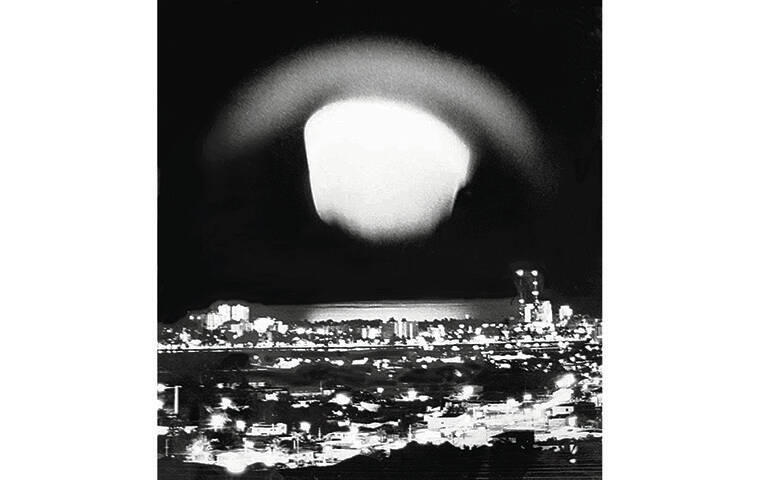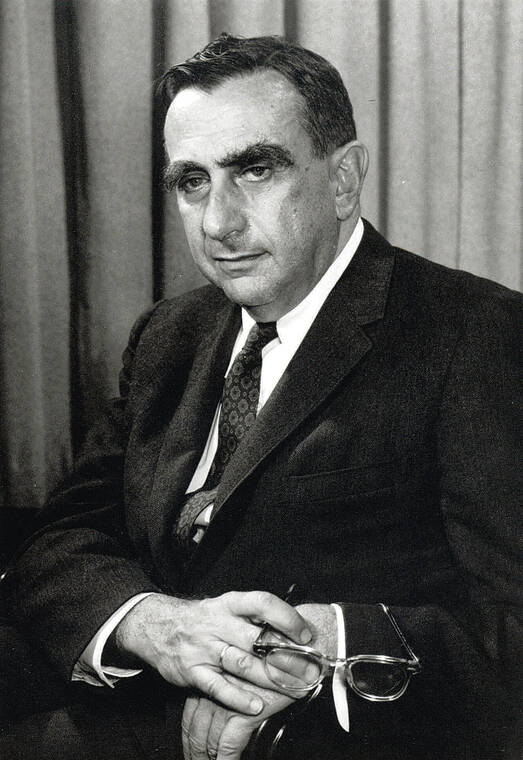Rearview Mirror: Oppenheimer film stirs up memories of Atomic Age

STAR-ADVERTISER / 1962
Nuclear tests above Johnston Atoll were visible in Hawaii skies from 1958 to 1962. Drivers stopped and got out of their cars to observe the event.

COURTESY PHOTO
Edward Teller:
The “father of the hydrogen bomb,” invited high school students to meet with him when he gave lectures at the University of Hawaii in 1962


The film “Oppenheimer” has reminded several islanders about the atomic tests that were visible in Hawaii skies in the 1950s and 1960s. The tests were high in the atmosphere and, despite the distance, visible from Hawaii.
Robert Oppenheimer led the Manhattan Project, which developed the first nuclear weapons. It employed over 125,000 people and cost over $2 billion.
Rick Lloyd said, “The incredible new movie that chronicles the creation of the atomic bomb has brought back a long-forgotten memory.
“It was July 8, 1962. I had been listening to radio reports that the U.S. was going to launch a hydrogen bomb above Johnston Atoll, 825 miles from Honolulu. It was set to go off at 11 p.m. our time.
“At that time, I lived about three blocks from the beach in Waikiki. I walked over and got a great spot on the beach to view the detonation. Right on schedule it went off.
“The sky turned a brilliant yellow. I spun around and saw that the heavy traffic on Kalakaua Avenue (the main drag through Waikiki) had stopped. Everybody was out of their cars and staring into the sky.
Don't miss out on what's happening!
Stay in touch with breaking news, as it happens, conveniently in your email inbox. It's FREE!
“It seemed to me that nobody said a word…TOTAL SILENCE!!
“Then the color began to change. From yellow, it turned to a yellowish green, then orange, ending blood red 360 degrees over Honolulu. The color change took about 45 minutes.
“This resulted in the greatest experience of horror in my life,” Lloyd concluded. “I was horrified by the thought that this monster weapon could be dropped on a population center. A nuclear war would likely destroy all life on earth.”
Frightening
Ken Fujii also recalled seeing the 1962 H-Bomb test above Johnston Atoll.
“About 50 UH residents at Atherton House YMCA gathered on the roof of the dorm, because the news reports said that the flash would be seen from Hawaii.
“Similar gatherings were held on the roofs of other dorms and hotels in Waikiki. It was almost a celebratory atmosphere on the roof.
“At the appointed time, we witnessed a bright yellow flash which immediately turned to an eerie greenish glow which covered the skies above Honolulu.
“The glow lit up the clouds and gradually faded after several long minutes but turned various shades of orange and purple as the light faded from the sky. We were all very quiet after viewing the green glow as the realization of what we had witnessed sunk in.
“We were also rather subdued after seeing the bomb’s eerie glow in the sky because about a dozen of the viewers on the roof of our dorm that night were students from Japan. They, especially, were very quiet while the bomb’s glow changed from neon green to other colors before fading away.
“I’m sure that they had vivid memories of the bombs which were dropped on their country a decade and a half earlier on Hiroshima and Nagasaki.
“My dorm roommate, Tommy from Kyoto, Japan, only said, ‘osoroshii’ or ‘frightening’ as his only comment.
“The next day, the Honolulu Advertiser had a front-page photo of the bright glow lighting up the night skies over the city.”
Detonations
Jerry Mayfield said, “I remember the hydrogen bomb test on July 8, 1962, and also the very first atomic bomb test at the Trinity Site north of Alamogordo, N.M. in 1945.
“I witnessed the Johnston Atoll hydrogen detonation from a balcony lanai at Tripler Army Medical Center as a first-year orthopedic resident.
“Seventeen years earlier, I had observed the first Trinity Site explosion as a thirteen-year-old when I awoke early to milk our cows at my home near Las Cruces, N.M., 100 miles to the southwest.
“A sudden, large flash on the horizon followed by a decreasing glow. There was a great secrecy surrounded it all until the Hiroshima bombing.”
First atomic test
The first atomic test that Mayfield witnessed was in New Mexico on July 16, 1945. Hiroshima was bombed three weeks later on Aug. 6, 1945, and Nagasaki on August 9, 1945.
Ed McMillan worked on the bomb and observed the explosion in 1945. He and others were just 5 miles from the blast site. “I was aware of a sensation of heat on my face and hands, which lasted about a second,” he said.
“The ball of fire could be seen rising and expanding and slowly fading out. The ball I estimated to be about a mile in diameter and four miles off the ground.
“The immediate reaction of the watchers was one of awe rather than excitement. After some minutes of silence, a few people made remarks like, ‘Well, it worked,’ and then conversations and discussion became general.
“I am sure that all who witnessed this test went away with a profound feeling that they had seen one of the great events of history.”
Brush with history
Dr. Richard Lee-Ching said, “When the movie “Oppenheimer” came out, I talked with my daughter about a long-ago brush with history.
“In 1966, the University of Hawaii invited Edward Teller, part of the brain trust at Los Alamos and the Manhattan Project to be a summertime guest and give some lectures.
“Teller was part of the group that headed up the hydrogen bomb project, which relied on fusion rather than fission.” He has been called “the father of the hydrogen bomb.”
Teller asked if he could give a series of lessons to high school students in addition to graduate students and professors. “So, besides teaching high level physics, he wound up giving talks on elementary physics to high school students.
“It was determined that high schools throughout the state could each send one student, and most of us had no physics background. Given the nature of students enjoying science at that time, we were all classic nerds with pocket protectors, slide rules, and clear social retardation.
“Dr. Teller was great, spontaneous and passionate. He had the bushiest eyebrows I had ever seen, with hair like Einstein’s. It seemed like all the physicists of the time either had bushy, untamed hair or were balding.
“He never talked down to us, and it almost seemed like we were in a graduate class of physicists at UH.
“I graduated from Mid-Pacific Institute, and the best friends I made in that class were from Ka‘u and Roosevelt. I decided to go into medicine, while my friend from Ka‘u wound up in engineering, but we remember fondly our contact with history.
“We were impressed by Dr. Teller, but really, it wasn’t until much later that we really understood how lucky we were to have met him.”
Edward Teller
Ken Goldstein also met Teller. “I was chosen by my high school to visit Los Alamos in 1962. I missed the bus back to my hotel because I was talking with Edward Teller about career fields.
“He advised me to stick with engineering instead of physics, because they killed fewer people. I took his advice, and had an interesting career, but I did marry a physicist!”
Engineers kill fewer people than physicists? Goldstein explained. “Well, most of us don’t make bombs, or at least I didn’t, with undergrad degrees in chemical and petroleum engineering. The closest I came was designing nuclear reactors, and helping to design what is now ‘fracking.’
“Teller was interesting. I had to listen hard to understand his accent, but at least he didn’t talk very fast. He had introduced himself, but it wasn’t until years later when I realized who he really was.
“Back then, he was just an older man who seemed very interested in why a high school student was planning to study a hard field like engineering.
“His office was an over-cluttered mine field, and I couldn’t twitch without knocking something over!
“He was both surprised and pleased that a high school junior had already studied calculus and differential equations, but he didn’t seem to believe me when I told him that I enjoyed math.
“I wanted to know more about what he did, but he just shook his head, and waved his hand at me each time I asked. That was my only disappointment, because another scientist had taken us around the lab, and explained what some of the equipment did, and I was excited to find out how Teller was using them.
“Physically, he was shorter than my 5’-10” but I couldn’t tell how large he was, because his suit didn’t fit well at all.
“He sat behind his desk, but stood up to ask a question, or to make a point, and I remember being surprised that he was actually carrying on a conversation with me.
“Somebody came in to tell him that I would miss my bus, but Teller just waved him away, and drove me to my hotel when he was good and ready.”
———
Bob Sigall is the author of the five “The Companies We Keep” books. Contact him at Sigall@Yahoo.com or sign up for his free email newsletter at RearviewMirrorInsider.com.




